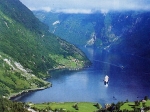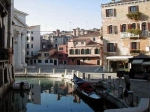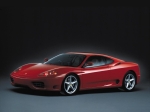Venice ( Italian Venezia ), the city of canals , is the capital of the region of Veneto , population 274,000 (2003). The city stretches across numerous small islands in a marshy lagoon along the Adriatic Sea in northeast Italy . The saltwater lagoon stretches along the shoreline between the mouths of the Po (south) and the Piave (north) Rivers. The Venetian Republic was a major sea power and a staging area for the Crusades , as well as a very important center of commerce (especially the spice trade ) and art in the Renaissance .
History
The city was founded as a result of the influx of refugees into the marshes of the Po estuary following the invasion of northern Italy by the Lombards in 568 . In the mid- 8th century , the Venetians resisted the empire-building efforts of Pepin III and remained subject to the Byzantine Empire , at least theoretically. As the community continued to develop and as Byzantine power waned, however, an increasingly anti-Eastern character emerged, leading to the growth of autonomy and eventual independence . Venice was a city state (an Italian thalassocracy or Repubblica Marinara , the other three being Genoa , Pisa , and Amalfi ). Its strategic position at head of the Adriatic made Venetian naval and commercial power almost invulnerable.
In the 12th century the essentials for the power of Venice were laid: the Arsenal was under construction in 1104; Venice wrested control of the Brenner pass from Veronia in 1178, opening a lifeline to silver from Germany; the last autocratic doge, Vitale Michiele, died in 1172.
 The Republic of Venice seized the eastern shores of the Adriatic before 1200 , mostly for commercial reasons, because pirates based there were a menace to trade. The Doge already carried the titles Duke of Dalmatia and Duke of Istria . Later mainland possessions, which extended across Lake Garda as far west as the River Adda , were known as "Terrafirma", and were acquired partly as a buffer against beligerent neighbors, partly to guarantee Alpine trade routes, and partly to ensure the supply of mainland wheat , on which the city depended. In building its maritime commercial empire, the Republic acquired control of most of the islands in the Aegean , including Cyprus and Crete , and became a major power-broker in the Near East . By the standards of the time, Venice's stewardship of its mainland territories was relatively enlightened and the citizens of such towns as Bergamo , Brescia , and Verona rallied to the defence of Venetian sovereignty when it was threatened by invaders.
The Republic of Venice seized the eastern shores of the Adriatic before 1200 , mostly for commercial reasons, because pirates based there were a menace to trade. The Doge already carried the titles Duke of Dalmatia and Duke of Istria . Later mainland possessions, which extended across Lake Garda as far west as the River Adda , were known as "Terrafirma", and were acquired partly as a buffer against beligerent neighbors, partly to guarantee Alpine trade routes, and partly to ensure the supply of mainland wheat , on which the city depended. In building its maritime commercial empire, the Republic acquired control of most of the islands in the Aegean , including Cyprus and Crete , and became a major power-broker in the Near East . By the standards of the time, Venice's stewardship of its mainland territories was relatively enlightened and the citizens of such towns as Bergamo , Brescia , and Verona rallied to the defence of Venetian sovereignty when it was threatened by invaders.
Venice became an imperial power following the Fourth Crusade , which (with Venetian aid) seized Constantinople in 1204 and established the Latin Empire . Considerable plunder was brought back to Venice, including the Winged Lion of St. Mark , symbol of Venice. Only Venetian ships could efficiently transport the men, supplies, and (especially) war horses.
The Venetian governmental structure was a mix of Byzantine and Islamic systems, but the social order was entirely feudal . Church and various private properties were tied to military service, though there was no knight tenure within the city itself. The Cavalieri di San Marco was the only order of chivalry ever instituted in Venice, and no citizen could accept or join a foreign order without the government's consent. Venice remained a republic throughout its independent period and politics and the military were kept completely separate. War was regarded as a continuation of commerce by other means (hence, the city's early production of large numbers of mercenaries for service elsewhere).
The chief executive was the Doge (duke), who, theoretically, held his elective office for life. In practice, a number of Doges were forced by pressure from their oligarchical peers to resign the office and retire into monastic seclusion when they were felt to have been discredited by perceived political failure.
Though the people of Venice generally remained orthodox Roman Catholics , the state of Venice was notable for its freedom from religious fanaticism and it enacted not a single execution for religious heresy during the Counter-Reformation . This apparent lack of zeal contributed to its frequently coming into conflict with the Papacy . Venice was threatened with the interdict on a number of occasions and twice suffered its imposition. The second, more famous, occasion was on April 27 , 1509 , by order of Pope Julius II (see League of Cambrai ).
Venetian ambassadors sent home still-extant secret reports of the politics and rumours of European courts, providing fascinating information to modern historians.
After 1070 years, the Republic lost its independence when Napoleon Bonaparte on May 12 , 1797 , conquered Venice during the First Coalition . The French conqueror brought to an end the most fascinating century of its history: It was during the "Settecento" that Venice became perhaps the most elegant and refined city in Europe , greatly influencing art , architecture , and literature . Napoleon was seen as something of a liberator by the city's Jewish population. He removed the gates of the Ghetto and ended the restrictions on when and where Jews could live and travel in the city.
Venice became part of the Austrian-held Kingdom of Lombardy-Venetia when Napoleon signed the Treaty of Campo Formio on October 12 1797. The Austrians took control of the city on January 18 , 1798 . It was taken from Austria by the Treaty of Pressburg in 1805 and became part of Napoleon's Kingdom of Italy , but was returned to Austria following Napoleon's defeat in 1814 . In 1866 , along with the rest of Venetia, Venice became part of Italy. After 1797, the city fell into a serious decline, with many of the old palaces and other buildings abandoned and falling into disrepair, although the Lido became a popular beach resort in the late 19th century.
Naval and military affairs
By 1450 , more than 3,000 Venetian merchant ships were in operation, and most of these could be converted when necessary into either warships or transports. The government required each merchant ship to carry a specified number of weapons (mostly crossbows and javelins ) and armor ; merchant passengers were also expected to be armed and to fight when necessary. A reserve of some 25 (later 100) war-galleys was maintained in the Arsenal . Galley slaves did not exist in medieval Venice, the oarsmen coming from the city itself or from its possessions, especially Dalmatia. Those from the city were chosen by lot from each parish, their families being supported by the remainder of the parish while the rowers were away. Debtors generally worked off their obligations rowing the galleys. Rowing skills were encouraged through races and regattas .
By 1303 , crossbow practice had become compulsory in the city, with citizens training in groups. As weapons became more expensive and complex to operate, professional soldiers were assigned to help work merchant sailing ships and as rowers in galleys. The company of "Noble Bowmen" was recruited in the later 14th century from among the younger aristocracy and served aboard both war-galleys and armed merchantmen, with the privilege of sharing the captain's cabin.
Though Venice was famous for its navy , its army was equally effective. In the 13th century , most Italian city states already were hiring mercenaries , but Venetian troops were still recruited from the lagoon, plus feudal levies from Dalmatia and Istria. In times of emergency, all males between seventeen and sixty years were registered and their weapons were surveyed, with those called to actually fight being organized into companies of twelve. The register of 1338 estimated that 30,000 Venetian men were capable of bearing arms; many of these were skilled crossbowmen. As in other Italian cities, aristocrats and other wealthy men were cavalrymen while the city's conscripts fought as infantry .
Early in the 15th century , as new mainland territories were expanded, the first standing army was organized, consisting of condottieri on contract. In its alliance with Florence in 1426 , Venice agreed to supply 8,000 cavalry and 3,000 infantry in time of war, and 3,000 and 1,000 in peacetime. Later in that century, uniforms were adopted that featured red-and-white stripes, and a system of honors and pensions developed. Throughout the 15th century, Venetian land forces were almost always on the offensive and were regarded as the most effective in Italy, largely because of the tradition of all classes carrying arms in defense of the city and official encouragement of general military training.
The command structure in the army was different from that in the fleet. By ancient law, no nobleman could command more than twenty-five men (to prevent against sedition by private armies), and while the position of Captain General was introduced in the mid-14th century, he still had to answer to a civilian panel of twenty "wise men". Not only was efficiency not degraded, this policy saved Venice from the military takeovers that other Italian city states so often experienced. A civilian commissioner (not unlike a commissar ) accompanied each army to keep an eye on things, especially the mercenaries. The Venetian military tradition also was notably cautious; they were more interested in achieving success with a minimum expense of lives and money than in the pursuit of glory.
Transportation
Venice is famous for its canals . It is built on an archipelago of more than 100 islands in a shallow lagoon . In the old center, the canals serve the function of roads, and every form of transport is on water or on foot. In the 19th century a causeway to the mainland brought a railroad station to Venice, and an automobile causeway and parking lot was added in the 20th century . Beyond these land entrances at the northern edge of the city, transportation within the city remains, as it was in centuries past, entirely on water or on foot. Venice is Europe's largest carfree area , unique in Europe in remaining a sizable functioning city in the 21st century entirely without motorcars or trucks.
The classical Venetian boat is the gondola , although it is now mostly used for tourists, or for weddings, funerals, or other ceremonies, due to its cost. Most Venetians now travel by motorised waterbuses ("vaporetti") which ply regular routes along the major canals and between the city's islands. The city also has many private boats. The only unmotorized gondolas still in common use by Venetians are the traghetti , foot passenger ferries crossing the Grand Canal at certain points without bridges.
Venice is served by the newly rebuilt Marco Polo International Airport , or Aeroporto di Venezia Marco Polo , named in honor of its famous citizen. The airport is on the mainland and was rebuilt away from the coast so that visitors now need to get a bus to the pier, from which watertaxi or Aliliguna waterbus can be used.




